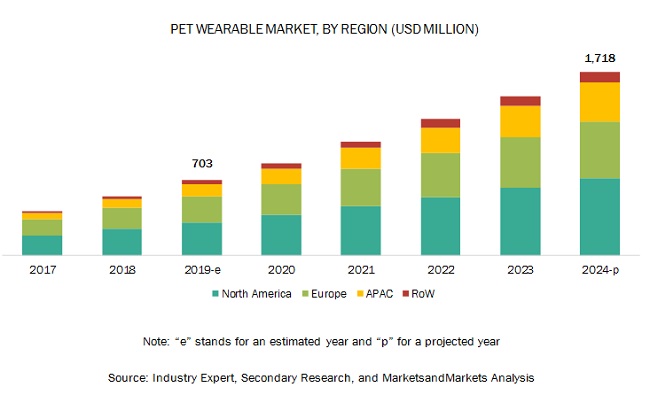NY, USA, September-24, 2019 /Global Semiconductor Industry ---
The growth of the pet wearable market can be attributed to the increasing concerns toward pet health and wellbeing, and rising pet population and pet humanization, and growing expenditure on pets due to high disposal income. Moreover, rapid advancements in WAN and LPWAN technologies and exponential demand for pet wearables from developing countries in APAC is expected to create substantial growth opportunities for the pet wearable market players.
The growth of the pet wearable market can be attributed to the increasing concerns toward pet health and wellbeing, and rising pet population and pet humanization, and growing expenditure on pets due to high disposal income. Moreover, rapid advancements in WAN and LPWAN technologies and exponential demand for pet wearables from developing countries in APAC is expected to create substantial growth opportunities for the pet wearable market players.
• Ask for Sample Pages of Report :- https://www.marketsandmarkets.com/requestsampleNew.asp?id=51308545
Scope of Pet Wearable Market: The growth of the market is attributed to the increasing concerns toward pet health and wellbeing, rising pet population & pet humanization, surging demand for IoT in pet tracking devices, and growing expenditure on pets due to high disposal income.

Major players in the pet wearable market covered in this report are Whistle Labs (US), PetPace (US), Garmin (US), FitBark (US), Tractive (Austria), Link AKC (US), Motorola (US), Num’Axes /EYENIMAL (France), KYON (Greece), Scollar (US), GoPro (US), and Felcana (UK).

Major players in the pet wearable market covered in this report are Whistle Labs (US), PetPace (US), Garmin (US), FitBark (US), Tractive (Austria), Link AKC (US), Motorola (US), Num’Axes /EYENIMAL (France), KYON (Greece), Scollar (US), GoPro (US), and Felcana (UK).
Browse 33 market data Tables and 21 Figures spread through 93 Pages and in-depth TOC on "Pet Wearable Market"
Cellular to register the highest CAGR in the overall market during the forecast period
In the pet wearable market, pet tracking and geofencing are the major use cases. Cellular technology can be ideal for pet wearable applications such as location tracking with the help of GPS pet trackers that require operation over long distances. Cellular chips enable pet owners to pinpoints their pet’s exact location 24/7. These devices can play a vital role in finding stolen or lost pets and provide owners updates about their whereabouts on their smartphones.
Smart Collar to hold the largest size of pet wearable market during the forecast period
Smart collar accounted for the majority of the global pet wearable market revenue. Smart collars combined with other technologies and components such as Wi-Fi or Bluetooth and provides insights into pet such as their location, training activity, and more. This collar allows for tracking a pet’s location using GPS technology, and monitor, track & receive information and alerts about the pet’s health status and activities.
The rate of employment is increasing steadily around the world, and due to hectic lifestyle and long working hours, pet owners’ demand for smart-connected collars that enable them to connect with their pets from their workplace is rapidly increasing. Moreover, high demand and rising adoption for smart collars can be attributed to their features which maintain an accurate location history and help trigger smartphone notifications.
Pet Wearable in North America to hold the largest size of pet wearable market in coming years
In 2018, North America accounted for the largest share in the global pet wearable market. It is a major hub and an early adopter of new technologies. The increasing trend of pet adoption and humanization, growing disposable income, and rising per capita expenditure on animal healthcare are the factors driving the growth of the pet wearable market in this region. Moreover, North America is home to prominent pet wearable players, such as Whistle Labs, FitBark, and Garmin.
About MarketsandMarkets™
MarketsandMarkets’s flagship competitive intelligence and market research platform, "Knowledgestore" connects over 200,000 markets and entire value chains for deeper understanding of the unmet insights along with market sizing and forecasts of niche markets.
Contact:
Mr. Shelly Singh
MarketsandMarkets™ INC.
630 Dundee Road
Suite 430
Northbrook, IL 60062
USA : 1-888-600-6441
newsletter@marketsandmarkets.com
Mr. Shelly Singh
MarketsandMarkets™ INC.
630 Dundee Road
Suite 430
Northbrook, IL 60062
USA : 1-888-600-6441
newsletter@marketsandmarkets.com


